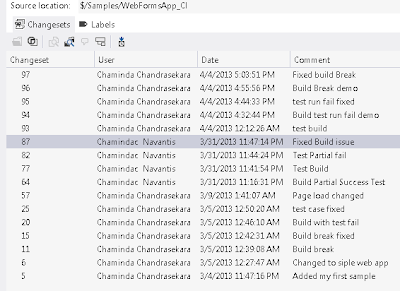If you have created a new release build definition with TFS for an application that is already in Production (which is deployed to production without a TFS build), you may want to do the next release build with changesets associated from a given changeset (from the last changeset delivered to Production).
To make it clear have a look at below source control history in my demo app. My changeset 87 has already gone into Production. Now I am creating a new TFS release build definition and when I queue a build in this release build I want it to get associated with chagesets 93 to 97.
If I queue a build with will build for latest sources in the TFS and no changesets get associated to the build.
To get my changesets 93 to 97 associated to build first I need to build for changeset 87. Then I can build for latest solution and it will associate from 93 to 97.
I can specify the changeset to build by advance options "Get Version" when I queue a build like below.
Now when I queue the build it builds for changeset 87.
Now I queue another build with
not specifying a changeset. This will build the latest sources
This build will associate the changesets from 93 to 97 as I expected
If it is necessary I can repeat the same steps to do another build from this definition to associate set of changesets that I would like to associate with it.
I will explain how to generate a Build Note with TFS build in my next post.


























